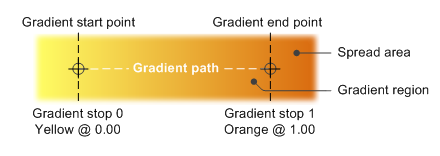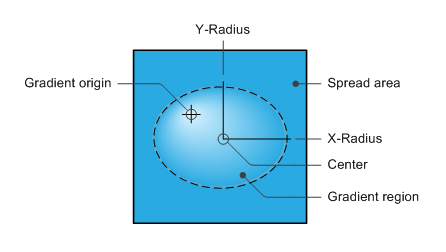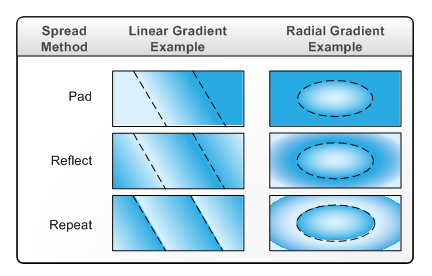IXpsOMGradientBrush interface (xpsobjectmodel.h)
This interface describes a gradient that is made up of gradient stops. Classes that inherit from IXpsOMGradientBrush specify different ways of interpreting gradient stops.
IXpsOMGradientBrush is the base interface for the IXpsOMLinearGradientBrush and IXpsOMRadialGradientBrush interfaces.
Inheritance
The IXpsOMGradientBrush interface inherits from IXpsOMBrush. IXpsOMGradientBrush also has these types of members:
Methods
The IXpsOMGradientBrush interface has these methods.
| IXpsOMGradientBrush::GetColorInterpolationMode Gets the gamma function to be used for color interpolation. |
| IXpsOMGradientBrush::GetGradientStops Gets a pointer to an IXpsOMGradientStopCollection interface that contains the collection of IXpsOMGradientStop interfaces that define the gradient. |
| IXpsOMGradientBrush::GetSpreadMethod Gets the XPS_SPREAD_METHOD value, which describes how the area outside of the gradient region will be rendered. |
| IXpsOMGradientBrush::GetTransform Gets a pointer to the IXpsOMMatrixTransform interface that contains the resolved matrix transform for the brush. (IXpsOMGradientBrush.GetTransform) |
| IXpsOMGradientBrush::GetTransformLocal Gets a pointer to the IXpsOMMatrixTransform interface that contains the local, unshared, resolved matrix transform for the brush. |
| IXpsOMGradientBrush::GetTransformLookup Gets the name of the lookup key of the shared matrix transform interface that is to be used for the brush. |
| IXpsOMGradientBrush::SetColorInterpolationMode Sets the XPS_COLOR_INTERPOLATION value, which describes the gamma function to be used for color interpolation. |
| IXpsOMGradientBrush::SetSpreadMethod Sets the XPS_SPREAD_METHOD value, which describes how the area outside of the gradient region is to be rendered. |
| IXpsOMGradientBrush::SetTransformLocal Sets the IXpsOMMatrixTransform interface pointer to a local, unshared matrix transform that is to be used for the brush. |
| IXpsOMGradientBrush::SetTransformLookup Sets the name of the lookup key of a shared matrix transform that is to be used for the brush. |
Remarks
The methods of this interface define the basic parameters of a gradient. The gradient type, which can be linear or radial, determines how these parameters are applied.
As shown in the figure that follows, the start and end points of a linear gradient mark the end points of the gradient path. The gradient path is the straight line that connects the start and end points. The gradient region of a linear gradient consists of the area between the start and end points, including those points, and extends in both directions at a right angle to the gradient path. The spread area is the area outside the gradient region.
Gradient stops define the color at specific locations along the gradient path; the color is interpolated along the gradient path between the gradient stops, as shown in the following illustration.
 As shown in the figure that follows, the gradient region of a radial gradient is the area enclosed by the ellipse that is described by the center point and the x and y radii that extend from the center point. The spread area is the area outside of that ellipse. The gradient path is a radial line that sweeps the entire gradient region from the gradient origin to the ellipse that bounds the gradient region. In the following illustration, the gradient path is not shown.
As shown in the figure that follows, the gradient region of a radial gradient is the area enclosed by the ellipse that is described by the center point and the x and y radii that extend from the center point. The spread area is the area outside of that ellipse. The gradient path is a radial line that sweeps the entire gradient region from the gradient origin to the ellipse that bounds the gradient region. In the following illustration, the gradient path is not shown.
 The spread method describes how the spread area is filled. Implementation of the spread method depends on the gradient type (linear or radial). The following illustration shows several examples of how the spread area can be filled. For information about different spread methods, see XPS_SPREAD_METHOD.
The spread method describes how the spread area is filled. Implementation of the spread method depends on the gradient type (linear or radial). The following illustration shows several examples of how the spread area can be filled. For information about different spread methods, see XPS_SPREAD_METHOD.
 The transform determines how the resulting gradient is transformed. The visible part of the gradient that is ultimately rendered in the image is determined by the path, stroke, or glyph that is using the gradient brush.
The transform determines how the resulting gradient is transformed. The visible part of the gradient that is ultimately rendered in the image is determined by the path, stroke, or glyph that is using the gradient brush.
Requirements
| Requirement | Value |
|---|---|
| Minimum supported client | Windows 7, Windows Vista with SP2 and Platform Update for Windows Vista [desktop apps | UWP apps] |
| Minimum supported server | Windows Server 2008 R2, Windows Server 2008 with SP2 and Platform Update for Windows Server 2008 [desktop apps | UWP apps] |
| Target Platform | Windows |
| Header | xpsobjectmodel.h |
See also
Feedback
Coming soon: Throughout 2024 we will be phasing out GitHub Issues as the feedback mechanism for content and replacing it with a new feedback system. For more information see: https://aka.ms/ContentUserFeedback.
Submit and view feedback for